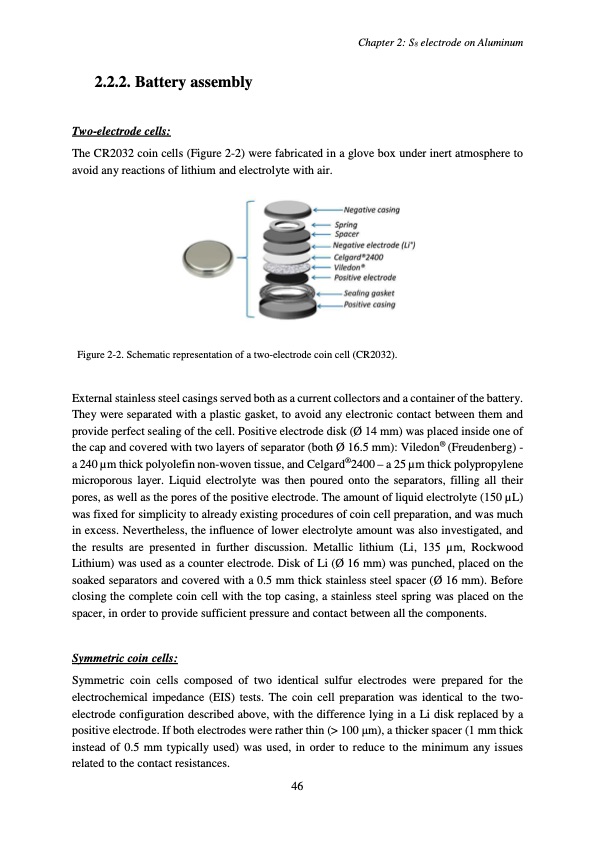
PDF Publication Title:
Text from PDF Page: 050
2.2.2. Battery assembly Two-electrode cells: The CR2032 coin cells (Figure 2-2) were fabricated in a glove box under inert atmosphere to avoid any reactions of lithium and electrolyte with air. Figure 2-2. Schematic representation of a two-electrode coin cell (CR2032). External stainless steel casings served both as a current collectors and a container of the battery. They were separated with a plastic gasket, to avoid any electronic contact between them and provide perfect sealing of the cell. Positive electrode disk (Ø 14 mm) was placed inside one of the cap and covered with two layers of separator (both Ø 16.5 mm): Viledon® (Freudenberg) - a 240 μm thick polyolefin non-woven tissue, and Celgard®2400 – a 25 μm thick polypropylene microporous layer. Liquid electrolyte was then poured onto the separators, filling all their pores, as well as the pores of the positive electrode. The amount of liquid electrolyte (150 μL) was fixed for simplicity to already existing procedures of coin cell preparation, and was much in excess. Nevertheless, the influence of lower electrolyte amount was also investigated, and the results are presented in further discussion. Metallic lithium (Li, 135 μm, Rockwood Lithium) was used as a counter electrode. Disk of Li (Ø 16 mm) was punched, placed on the soaked separators and covered with a 0.5 mm thick stainless steel spacer (Ø 16 mm). Before closing the complete coin cell with the top casing, a stainless steel spring was placed on the spacer, in order to provide sufficient pressure and contact between all the components. Symmetric coin cells: Symmetric coin cells composed of two identical sulfur electrodes were prepared for the electrochemical impedance (EIS) tests. The coin cell preparation was identical to the two- electrode configuration described above, with the difference lying in a Li disk replaced by a positive electrode. If both electrodes were rather thin (> 100 μm), a thicker spacer (1 mm thick instead of 0.5 mm typically used) was used, in order to reduce to the minimum any issues related to the contact resistances. Chapter 2: S8 electrode on Aluminum 46PDF Image | Accumulateur Lithium Soufre

PDF Search Title:
Accumulateur Lithium SoufreOriginal File Name Searched:
WALUS_2015_archivage.pdfDIY PDF Search: Google It | Yahoo | Bing
Sulfur Deposition on Carbon Nanofibers using Supercritical CO2 Sulfur Deposition on Carbon Nanofibers using Supercritical CO2. Gamma sulfur also known as mother of pearl sulfur and nacreous sulfur... More Info
CO2 Organic Rankine Cycle Experimenter Platform The supercritical CO2 phase change system is both a heat pump and organic rankine cycle which can be used for those purposes and as a supercritical extractor for advanced subcritical and supercritical extraction technology. Uses include producing nanoparticles, precious metal CO2 extraction, lithium battery recycling, and other applications... More Info
| CONTACT TEL: 608-238-6001 Email: greg@infinityturbine.com | RSS | AMP |